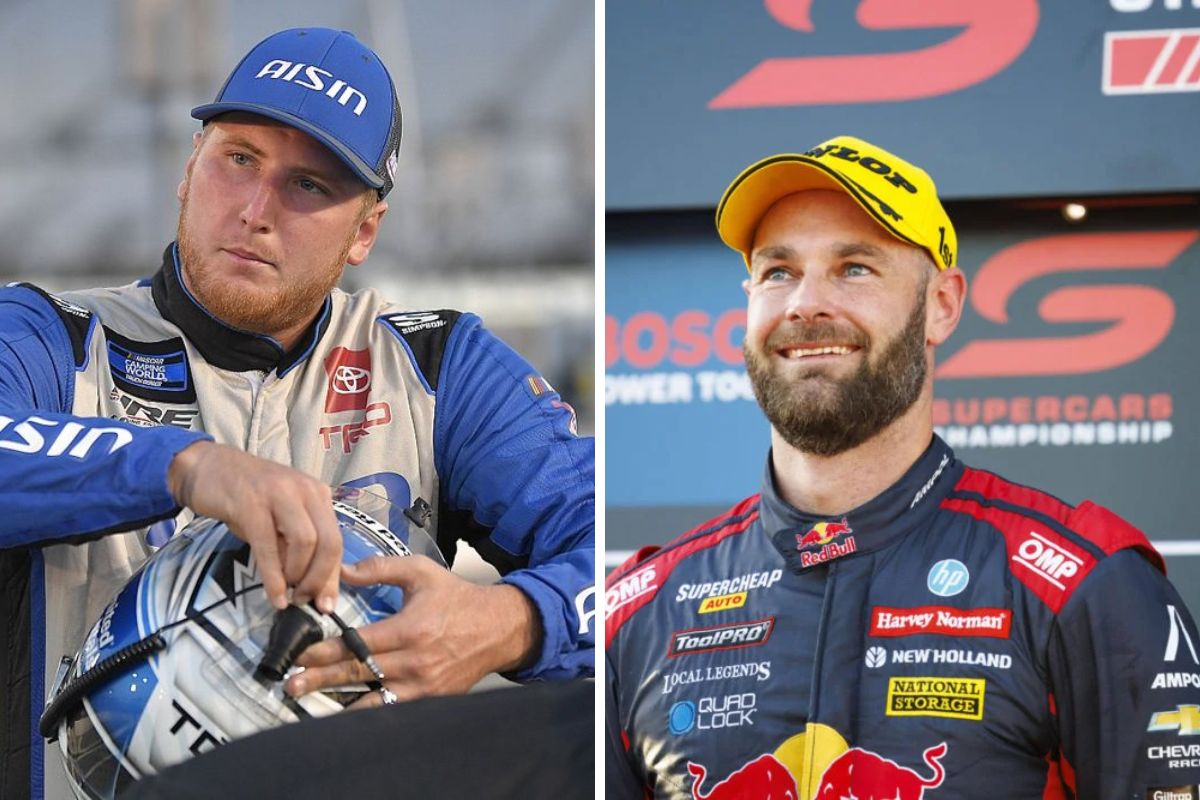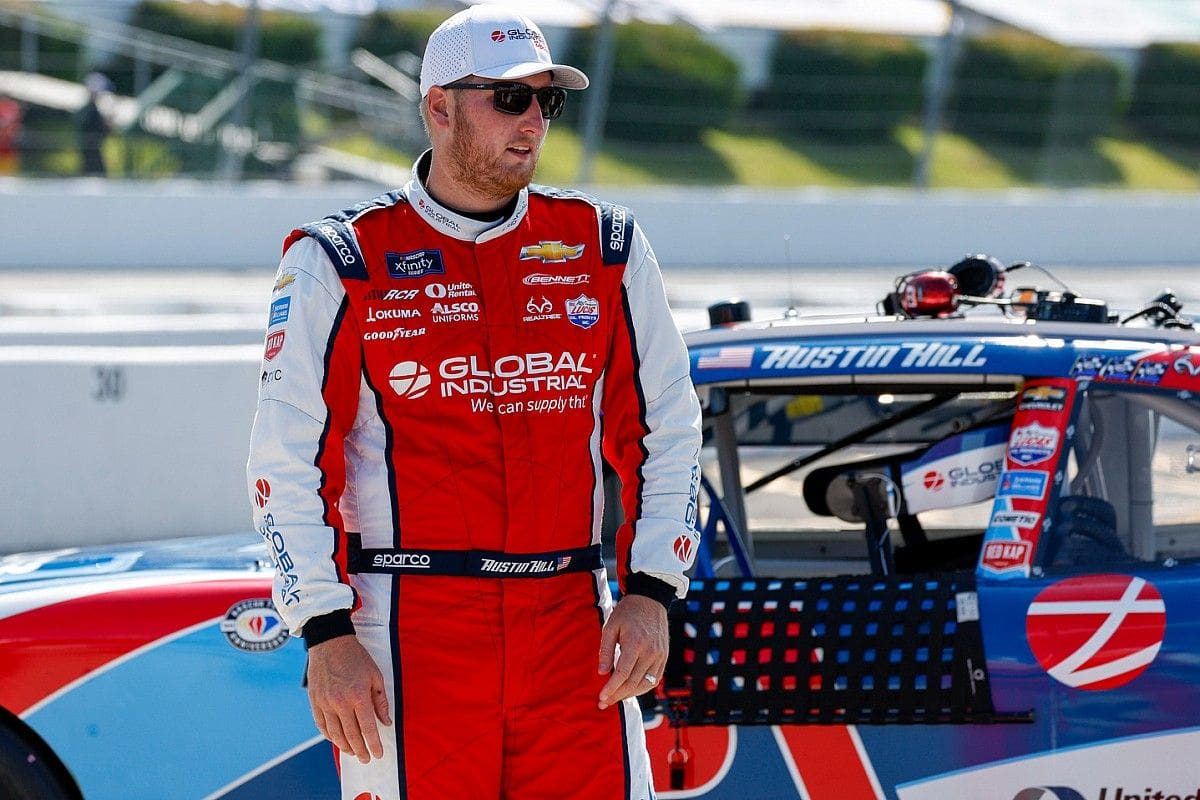Hill and Van Gisbergen Penalized: The recent penalties imposed on Austin Hill and Shane van Gisbergen, following a technical inspection at Talladega Superspeedway, spotlight the rigorous enforcement of NASCAR’s regulations. This incident, involving significant repercussions such as loss of pit selection and crew member ejections, raises probing questions about the balance between strict rule adherence and the dynamic nature of motorsport competition. As the drivers recalibrate their strategies under these new constraints, one wonders how this will affect their performance in an already unpredictable racing environment. This scenario sets the stage for a compelling discussion on the implications of such penalties in high-stakes races.
Key Takeaways
- Austin Hill and Shane van Gisbergen faced penalties after failing technical inspections at Talladega.
- The penalties include loss of pit selection and ejection of a crew member for each team.
- Hill retains his pole position at Dover despite the setback, influencing his race strategy.
- Van Gisbergen’s repeated infractions test his resilience and may affect his aggressive driving style.
- These penalties impact the competitive dynamics and strategies for the upcoming Dover race.
Technical Inspection Issues at Talladega
The technical inspection at Talladega Superspeedway has cast a shadow of uncertainty over several drivers’ preparations for the upcoming Ag-Pro 300 race. This necessary procedure, designed to guarantee all vehicles meet NASCAR’s strict safety and performance standards, has historically been a pivotal moment pre-race, influencing team strategies and driver morale.
At Talladega, the scrutiny of technical inspections is intensified due to the track’s reputation for high-speeds and close-quarter racing, making compliance with regulations not just a matter of legality but of utmost safety. The inspectors wield a detailed checklist, covering everything from engine specifications to the minutiae of aerodynamic configurations. This thorough examination ensures that no competitive advantages are gained through modifications that stray from the NASCAR rulebook—a cornerstone principle in maintaining the sport’s competitive integrity.
Moreover, the timing of the inspections plays a critical role in shaping the pre-race atmosphere. Occurring mere hours before the engines roar to life, the findings can lead to last-minute adjustments that are as mentally taxing as they are physically demanding for the crews. Teams found in violation of the standards are forced into a race against time, making corrections that are critical to their eligibility to compete.
Understanding these dynamics is important for appreciating the pressures teams face in the lead-up to the race. The technical inspection is not merely a procedural hurdle but a defining moment that can alter the course of the weekend, testing the adaptability and resilience of teams under the strict gaze of regulatory compliance.

Drivers Failing Technical Inspection
Several drivers, including notable names like Hill, Allmendinger, and Van Gisbergen, faced setbacks at Talladega after failing the technical inspection twice, triggering significant penalties for their teams. This development not only disrupted their preparations but also cast a shadow over their prospects in the upcoming races, particularly at Dover where the consequences will be felt most acutely.
The failure of the technical inspection, a crucial pre-race procedure that guarantees all vehicles meet strict NASCAR safety and performance standards, led to the loss of pit selection privileges and the ejection of a crew member for each affected team in the next race. This is a significant disadvantage, as pit stall selection can critically influence a team’s race strategy and efficiency during pit stops, which are often pivotal to the outcome of the race.
For those unfamiliar, the inspection process involves several stages where cars are examined for compliance with the detailed regulations governing vehicle weight, dimensions, engine size, and other technical specifications. The aim is to maintain a level playing field and prevent any team from gaining an unfair advantage through technical tweaks.
The repercussions of failing this inspection are severe because they not only penalize the team in the immediate next race but also undermine their preparations and morale. The ejected crew members, often integral to the race day operations, leave a gap in the team’s on-ground strategy, further complicating their challenge.
As the teams regroup and address the issues that led to the inspection failures, they face a race against time to align with NASCAR’s stringent standards, while also recalibrating their strategies to tackle the upcoming challenges without some of their key personnel.
Garrett Smithley time disallowed in Xfinity qualifying (tech issue). He will be the DNQ b/c lowest in owner points of those not in top-33 in qualifying. Mason Massey now in.
— Bob Pockrass (@bobpockrass) April 19, 2024
Impact on Drivers like Austin Hill and Shane van Gisbergen
Facing penalties from the recent technical inspection failures, drivers Austin Hill and Shane van Gisbergen must now navigate added pressures and strategic disadvantages in the upcoming Dover race. Such penalties not only tarnish a driver’s immediate prospects but also cast long shadows over their season’s strategy and morale. For Hill, whose performance in the #21 Chevy has been particularly strong this season, the setback could disrupt a rhythm that has so far positioned him as a contender. The psychological burden of overcoming a penalty can shift a driver’s focus from aggressive racing to conservative, points-saving tactics.
Shane van Gisbergen, on the other hand, is no stranger to adversity. Having faced a similar situation following a penalty at COTA, Van Gisbergen’s resilience will be tested once more. The #97 Kaulig Racing Chevy’s performance at Talladega, where he managed a middle-of-the-pack finish despite potential, suggests that van Gisbergen is capable of impressive comebacks. However, the cumulative effect of repeated penalties could weigh heavily on his strategic decisions and mental fortitude.
Both drivers are now in a position where every decision on the track, every pit stop, and every strategic call is magnified in importance. The penalties not only affect their starting positions but also how they and their teams approach the race tactically. With less room for error, the focus must be razor-sharp, the execution flawless. In a sport where milliseconds can determine the outcome, these penalties could very well define the trajectory of their respective seasons.

Impact of Penalties on Dover Race
How will the penalties imposed on Austin Hill and Shane van Gisbergen shape the dynamics of the upcoming Dover race? The implications of these penalties are substantial, affecting not just the drivers involved but the race strategy and atmosphere as a whole.
For Hill, holding the pole position offers a significant advantage, as starting at the front in a track like Dover, with its high-banked, one-mile oval, usually leads to better control over race pace and immediate race tactics. His ability to maintain this advantage despite the penalty might provide him with the resilience to manage the race effectively from the front, barring any further incidents.
On the other hand, Shane van Gisbergen, known for his aggressive driving style and strategic acumen, will also not see an immediate impact on his race start. This situation could set a precedent for how penalties are perceived and strategized around in future races. Both drivers, known for their competitive nature and tactical prowess, might use this scenario to showcase their ability to overcome adversities, potentially making the Dover race a focal point for demonstrating resilience and strategic mastery.
Moreover, the penalties could influence the psychological aspects of the race. Competitors seeing that significant penalties do not disrupt starting positions might push harder, leading to a more aggressive and dynamic race. Consequently, this could alter the usual tactical approaches by teams and drivers, injecting an unpredictable element into the race’s unfolding. The crowd at Dover, expectant of a straightforward race, might instead witness a thrilling display of strategic depth and driver skill, making this race a memorable one in the NASCAR calendar.
In Xfinity tech … AHill Allmendinger VanGisbergen Bacarella TayGray and Bilicki cars failed twice (loss of pit selection for Dover and crew member ejection).
— Bob Pockrass (@bobpockrass) April 19, 2024
Twist of Fate for Mason Massey
In an unexpected turn of events, Mason Massey’s fortunes dramatically improved when Garrett Smithley’s qualifying time was disqualified, propelling Massey into the race lineup. This unforeseen twist not only reshapes the starting grid but also revives the hopes of the Fan Controlled Sports community, who now have another opportunity to make strategic race-day decisions for the #14 SS GreenLight Racing Chevy.
The dynamics at play here illustrate the unpredictable nature of NASCAR racing, where technical compliance is as essential as speed. Smithley’s disqualification due to an unsecured roof hatch—a seemingly minor oversight—has had significant repercussions, altering the competitive landscape of the Ag-Pro 300.
Here are four key aspects of this development:
- Increased Fan Engagement: Massey’s entry into the race reinvigorates the fan base, allowing them to participate actively in decision-making processes that could influence the race outcome.
- Strategic Opportunities: With a clean slate and nothing to lose, the #14 team can adopt aggressive or unconventional strategies that might be too risky for those in contention for the championship.
- Pressure on Performance: This unexpected entry puts Massey under the spotlight, testing his ability to capitalize on this fortuitous break and compete under pressure against seasoned racers.
- Implications for Smithley: For Garrett Smithley, this incident serves as a stark reminder of the importance of meticulous attention to detail in race preparations, potentially affecting his future prospects and reputation.
As the engines start, all eyes will be on Massey to see how this twist of fate plays out in his performance on race day.

News in Brief: Hill and Van Gisbergen Penalized Pre-Race Drama
The penalties imposed on drivers like Austin Hill and Shane van Gisbergen at Talladega Superspeedway underscore the strict enforcement of NASCAR’s technical regulations, necessary for ensuring fair competition.
Such sanctions, while disruptive, highlight the significance of compliance and the delicate balance teams must maintain between innovation and adherence to standards.
These events not only affect race day strategies but also serve as important reminders of the high standards required in professional motorsports, impacting championship dynamics as a whole.
Also Read: Austin Hill’s Talladega Curse Strikes: Late Race Contact Spoils Ag-Pro 300
